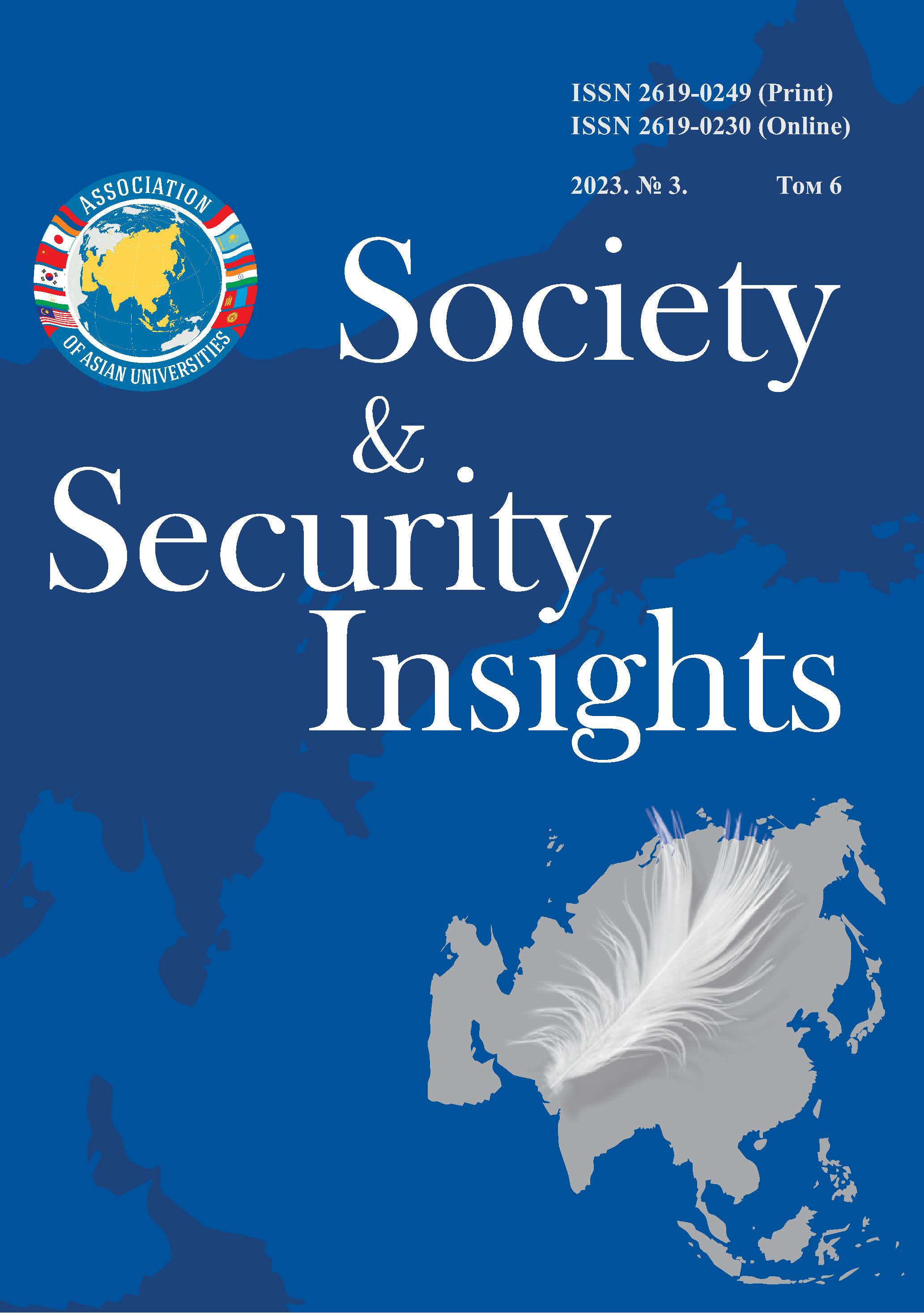Центральная Азия: историко-культурное наследие в структуре межнациональных отношений конца ХХ – начала XXI в.
Основное содержание статьи
Аннотация
В статье рассматриваются стратегии сохранения культурного наследия в странах постсоветской Центральной Азии. Его оценка как фактора суверенизации и выстраивания межнациональных взаимодействий определяет актуальность работы. Основой анализа являются нормативные документы, концепции и практики национального строительства и связанный с ними дискурс по поводу культурного наследия. Для достижения результатов используется аналитический, историко-культурный подход. В работе показано, что процессы актуализации культурного наследия стран макрорегиона развивались динамично; соответствовали мировым тенденциям; были закреплены на уровне национальных правовых систем, в академическом и общественно-политическом дискурсах. Утверждая национальные приоритеты, государства Центральной Азии ориентировались на многовекторное межународное сотрудничество. С созданием Содружества Независимых Государств процесс культурного диалога вышел на новый уровень. Формирование вариативных моделей интеграции определило один из основных трендов развития Центральной Азии начала XXI в.
Скачивания
Metrics
Детали статьи

Это произведение доступно по лицензии Creative Commons «Attribution» («Атрибуция») 4.0 Всемирная.
Authors retain the copyright of their manuscripts, and all Open Access articles are distributed under the terms of the Creative Commons Attribution License, which permits unrestricted use, distribution, and reproduction in any medium, provided that the original work is properly cited.
Литература
Абдимуминов, О. Б. Сотрудничество Центральной Азии и ЮНЕСКО // Молодой ученый. 2019. № 32. С. 70–72.
Амиров Р. Культура Таджикистана в условиях независимости (опыт, проблемы и перспективы развития) // Ученые записки Алтайской государственной академии культуры и искусств. Культура евразийского региона. 2017. № 2. С. 189–197.
Бакчиев Т. А. Манасоведение: учебное пособие для вузов. Бишкек : Улуу Тоолор, 2018. 208 с.
Баллер Э. А. Социальный вопрос и культурное наследие. М.: Наука, 1987. 160 с.
Белоглазов А. В., Надыров Р. Н. Роль ТЮРКСОЙ в процессе формирования тюркской идентичности в тюркоязычных государствах Центральной Азии в конце XX — начале XXI в. // Человеческий капитал. 2022. № 1. С. 61–67.
Гафуров Б. Г., Мирошников Л. И. Изучение цивилизаций Центральной Азии (опыт международного сотрудничества по проекту ЮНЕСКО). М. : Наука, 1976. 130 с.
Егоров Д. В. Переосмысливая евразийскую концепцию: проект евразийского союза Н.А. Назарбаева // Вестник РУДН. Серия: Политология. 2014. № 1. С. 51–59.
Курмангалиева Г. К. Культурное наследие прошлого в интеграционных процессах Казахстана и Центральной Азии. Адам Әлемі — Мир человека 2006. № 2(28). С. 6–15.
Назарбаев Н. А. В потоке истории. Алматы : Атамұра, 1999. 296 с.
Октябрьская И. В. Концепция культурного наследия: мировой и российский опыт формирования// Вестник НГУ. Серия: История, филология. 2013. Т. 12, вып. 3: Археология и этнография. С. 20–31.
Октябрьская И. В. Стратегии и практики сохранения национального культурного наследия стран СНГ: опыт интеграции в мировое культурное пространство // Межкультурный диалог на Евразийском пространстве. Древности Сибири и Центральной Азии. 2013а. № 6. С. 6–12.
Октябрьская И. В., Алымкулова С. К., Назаров И. И., Самушкина Е. В. Кыргызская Республика: концепция, стратегии и практики сохранения национального культурного наследия // Археология, этнография и антропология Евразии. 2022. Т. 50, № 2. С. 128–139.
Панченко А. Б. Евразийская парадигма в отечественном народоведении (история становления и научный потенциал) // Северо-Восточный гуманитарный вестник. 2018. № 1. С. 11–18.
Халанский И. В. Центральноазиатская интеграция: действительность и возможности // Вестник КРСУ. 2011. № 11. С. 30–34.
Чепайтене Р. Культурное наследие в глобальном мире. Вильнюс: Европейский гуманитарный университет, 2010. 298 с.
REFERENCES
Abdullaev, D.Kh., Kurbonboeva, A.U, & Merkureva, A.Iu. (2022). Cultural and historical heritage of Uzbekistan – the basis of the third renaissance. Academic research in educational sciences, 3, 540-544. (In Russ.).
Abdimuminov, O.B. (2019). Cooperation of the Central Asia and UNESCO. Molodoĭ uchenyĭ, 32(270), 70–72. (In Russ.).
Amirov, R. (2017). Culture of Tajikistan in conditions of independence (experience, problems and prospects of development). Uchenye zapiski Altaĭskoĭ gosudarstvennoĭ akademii kulʹtury i iskusstv. Kulʹtura evraziĭskogo regiona, 2, 189 –197. (In Russ.).
Bakchiev, T. A. (2018). Manasology: workbook for universities. Bishkek: Uluu Toolor. (In Russ.).
Baller, Ė.A. (1987). Social question and cultural heritage. Moscow: Nauka. (In Russ.).
Beloglazov, A.V., & Nadyrov, R.N (2022). Role of TURKSOY in the process of formation of Turkic identity in the Turkic-speaking states of Central Asia in the late XX - early XXI century. Chelovecheskiĭ kapital, 1, 61–67. (In Russ.).
Chepaĭtene, R. (2010). Cultural heritage in the globalized world. Vilnius: Evrop. gum. un-t. (In Russ.)
Egorov, D.V. (2014). Rethinking Eurasianism: the Eurasian Union Project of N.A. Nazarbaev. Vestnik RUDN, seriia Politologiia, 1, 51–59. (In Russ.)
Gafurov, B.G., Miroshnikov, L.I. (1976). Study of Civilizations of Central Asia (experience of international cooperation under UNESCO project). Moscow: Izdatelʹstvo Nauka. (In Russ.).
Khalanskiĭ, I.V. (2011). Central Asian integration: reality and opportunities. Vestnik KRSU, 11, 30–34. (In Russ.).
Kurmangalieva, G.K. (2006). Cultural heritage of the past in the integration processes of Kazakhstan and Central Asia. Adam Әlemі — Mir cheloveka, 2(28), 6-15. (In Russ.).
Nazarbaev, N.A. (1999). In the flow of history. Almaty: Atamұra. (In Russ.).
Oktiabrskaia, I.V. (2013). Concept of cultural heritage: world and Russian experience of formation. Vestnik NGU. Seriia: Istoriia, filologiia, 12(3), 20–31. (In Russ.).
Oktiabrskaia, I.V. (2013a) Strategies and Practices for the Preservation of the National Cultural Heritage of the CIS Countries: Experience of Integration into the World Cultural Space. Mezhkulturnyĭ dialog na Evraziĭskom prostranstve. Drevnosti Sibiri i Tsentralʹnoĭ Azii, 6, 6-12. (In Russ.).
Oktiabrskaia, I.V., Alymkulova, S.K., Nazarov, I.I., & Samushkina, E.V. (2022). Kyrgyz Republic: vision, strategies and practices for the preservation of national cultural heritage. Arkheologiia, ėtnografiia i antropologiia Evrazii, 2, 128–139. (In Russ.).
Panchenko, A.B. (2018). The Eurasian paradigm in the Russian national studies (history of formation and scientific potential). Severo-Vostochnyĭ gumanitarnyĭ vestnik, 1, 11–18/ (In Russ.).


 https://orcid.org/0000-0002-4190-9478
https://orcid.org/0000-0002-4190-9478